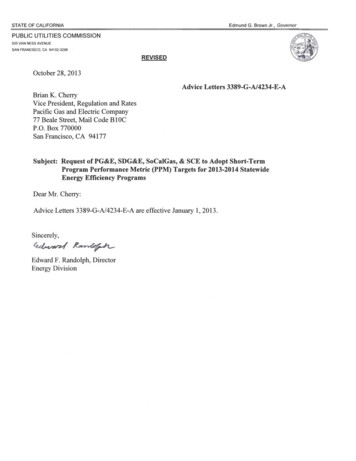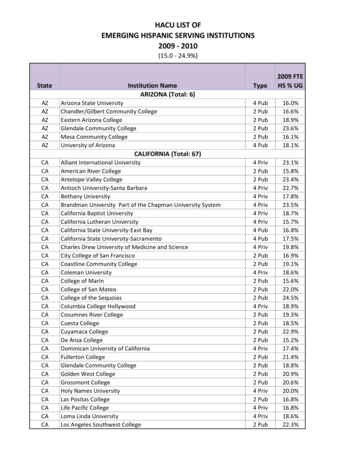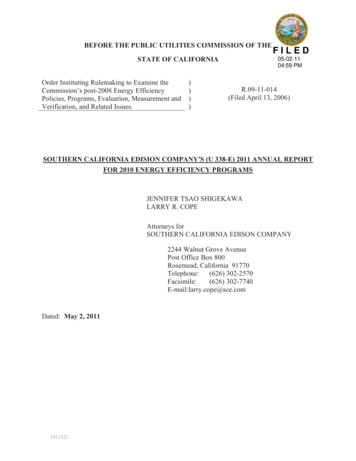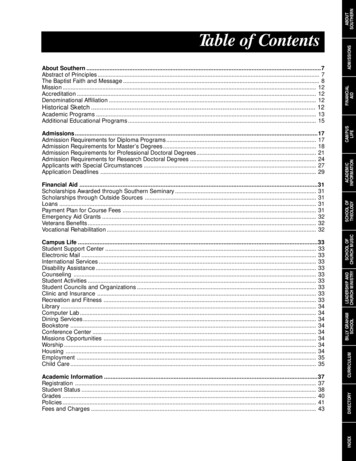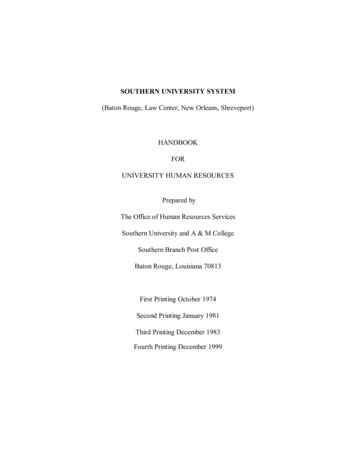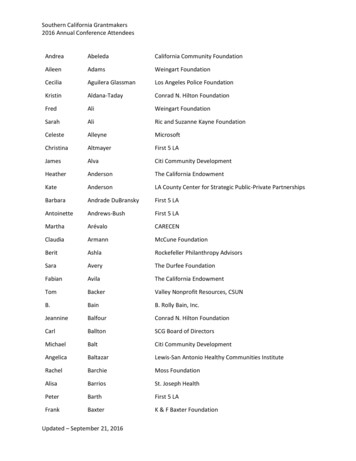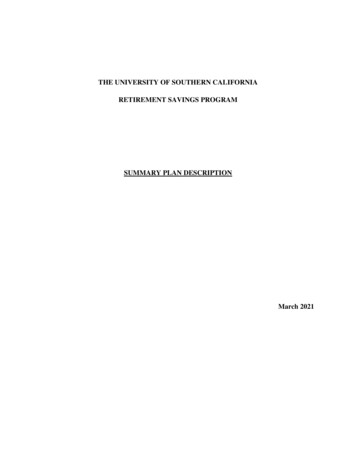
Transcription
THE UNIVERSITY OF SOUTHERN CALIFORNIARETIREMENT SAVINGS PROGRAMSUMMARY PLAN DESCRIPTIONMarch 2021
TABLE OF CONTENTSPageI. PROGRAM BACKGROUND . 21.What is the USC Retirement Savings Program?. 22.What was the university’s retirement program prior to July 1, 2007?. 23.How are plan accounts from merged physicianpractice group retirement plans treated? . 3II. ELIGIBILITY AND PARTICIPATION . 44.Who may participate in the USC Retirement Savings Program? . 45.When will I become a Participant for purposes ofMatched Employee Contributions, USC Non-ElectiveContributions and USC Match Contributions? . 56.How do I become a Participant for purposes of Supplemental EmployeeContributions? . 67.What if I have a change in status or am reemployedafter I have become a Participant? . 6III. CONTRIBUTIONS . 78.What contributions are made on my behalf under the Program?. 79.What is a Salary Reduction Election? . 710.How Much Can I Contribute through Matched Employee Contributionsand Supplemental Employee Contributions? . 811.Is there an overlap between my Matched Employee Contributionsand my Supplemental Employee Contributions? . 812.Can I contribute to the Program on both a pre-tax and Roth basis? . 913.May I change the amount of my Matched Employee Contributionsand Supplemental Employee Contributions? . 914.What are my Eligible Earnings for purposes of the Program? . 915.When will I become vested in my accumulations under the Program? . 1016.May I make contributions to the Retirement Savings Programfrom another retirement plan? . 11IV. INVESTMENT OF RETIREMENT SAVINGS PROGRAM ASSETS . 1117.How are contributions to the Retirement Savings Program invested? . 1118.How do I direct my investments? . 1319.Who is responsible for investment gains and losses? . 1320.Are there any investment fees or expenses? . 14-i-
21.Who will vote fund shares allocated to my custodial accountsor annuity contracts? . 1422.What additional information about investments is available? . 14V. DISTRIBUTIONS . 1423.When will I receive payments under the Retirement Savings Program?. 1424.How are benefits paid?. 1525.May I borrow from my accumulations under the Retirement Program? . 1626.What if I incur a financial hardship?. 1627.What if I become disabled?. 1728.What if I get divorced? . 1729.Are there circumstances when a withdrawal must be made? . 1830.What happens if I die before receiving all of my benefits? . 18VI. ADMINISTRATIVE AND OTHER IMPORTANT INFORMATION . 1931.Could I lose my right to benefits under the Retirement Savings Programor could the value of my benefits decrease? . 1932.Are there any other limits or restrictions on Retirement SavingsProgram contributions? . 2033.Are there income tax implications for Participants in theRetirement Savings Program?. 2034.What are the procedures for filing a claim under theRetirement Savings Program?. 2135.May the Retirement Savings Program change or be terminated in the future? . 2236.What are my rights under ERISA? . 2237.What other information do I need to be aware of? . 24-ii-
INTRODUCTIONThe University of Southern California offers eligible faculty and staff a RetirementSavings Program that involves contributions from both you and the university.This Summary Plan Description has been prepared to explain the major provisions of theUSC Retirement Savings Program in effect as of March 1, 2021, and to try to answer some of thequestions you might have. Although all possible care has been taken in the preparation of thisSummary Plan Description, it is not the official text of the university’s retirement plans. In theevent of any inconsistency between the information in this Summary and in the plans themselves,or to the extent the plans contain more complete or detailed information or rules, the provisionsof the plans will prevail.Copies of the actual plan documents are available for inspection in the Office ofRetirement Plan Administration during regular business hours. You may also contact the Officeof Retirement Plan Administration if you have any questions about this Retirement SavingsProgram.En este folleto se encuentra un resumen en inglés de los derechos ybeneficios incluidos en el Plan de Jubilación y en el Plan deImpuestos-Diferidos del Personal de Apoyo de la Universidad delSur de California. Si le es dificil comprender cualquier parte deeste folleto, póngase en contacto con el Centro de Servicios deRecursos Humanos en CUB (213-821-8100).IMPORTANT NOTE FOR THE 2021 PLAN YEARThe University has announced that employer non-elective contributions under theRetirement Savings Program will be suspended for 2021. Eligible employees will continue toreceive the University’s matching contributions but will not receive 5% non-electivecontributions for 2021.
I. PROGRAM BACKGROUND1.What is the USC Retirement Savings Program?Under the Program, you will automatically receive a university non-elective contributionof 5% of your eligible pay for each pay period after you become eligible, even if you do notcontribute to the Program. The Program also provides you with the opportunity to contribute upto 5% of your eligible pay each pay period and receive a matching university contribution of upto 5% of your eligible pay for the pay period. Further, in addition to your “Matched EmployeeContributions,” which are your contributions up to 5% of your eligible pay, you may alsocontribute additional “Supplemental Employee Contributions” up to the applicable federal limit.In this Summary Plan Description, the term “USC Non-Elective Contribution” refers to theautomatic 5% university contribution and the term “USC Match Contribution” refers to thematching contributions the university makes with respect to your Matched EmployeeContributions (up to an additional 5% if you make a 5% Matched Employee Contribution).The “Retirement Savings Program” is the nickname for two underlying plans: theUniversity of Southern California Defined Contribution Retirement Plan (the 401(a) plan underwhich USC Non-Elective and USC Match Contributions are made) and the University ofSouthern California Tax-Deferred Annuity Plan (the 403(b) plan under which your MatchedEmployee Contributions and Supplemental Employee Contributions are made).You are given a number of investment options for all amounts (that is, your MatchedEmployee Contributions, your Supplemental Employee Contributions, your USC Non-ElectiveContribution, and your USC Match Contributions) contributed under the Retirement SavingsProgram on your behalf. You may select from these options the combination that best suits yourneeds and objectives. The Retirement Savings Program is intended to be responsive to yourpersonal situation and competitive with the retirement programs offered by other institutions.2.What was the university’s retirement program prior to July 1, 2007?Prior to July 1, 2007, the university offered two separate programs, one for non-exemptstaff and one for faculty and exempt staff. As part of the Non-Exempt Staff Retirement Program, eligible non-exempt staffparticipated in a defined benefit plan called the Support Staff Retirement Plan (the“Staff Plan”). Effective June 30, 2007, for non-union participants and participantscovered by the university’s collective bargaining agreement with OPEIU Local 30,the Staff Plan was amended to freeze benefits as of June 30, 2007 and to fully vesteach participant who was an employee on June 30, 2007. Effective December 23,2009, for participants covered by the university’s collective bargaining agreementwith Unite Here Local 11, the Staff Plan was amended to freeze benefits as ofDecember 23, 2009 and to fully vest each participant who was an employee onDecember 23, 2009. Vested benefits under the Staff Plan will be paid in accordancewith the terms of that plan. Please see the summary plan description for the StaffPlan (available at df) for more-2-
information. Nonexempt staff were also permitted to make voluntary pre-taxcontributions up to the applicable federal limit. If you made voluntary contributionsunder the prior programs, your accounts and/or contracts under the new Programinclude your voluntary contributions, which are subject to the same rules asSupplemental Employee Contributions under the new Program. Eligible faculty and exempt staff participated in a defined contribution program thatprovided for mandatory 5% employee contributions and 10% universitycontributions. In addition, faculty and exempt staff were permitted to make voluntarypre-tax contributions up to the applicable federal limit. If you were a participant inthis program prior to July 1, 2007, your accounts and/or contracts under the newProgram include your prior mandatory contributions, voluntary contributions anduniversity contributions. Your prior mandatory contributions are subject to the samerules as Matched Employee Contributions, and your prior voluntary contributions aresubject to the same rules as Supplemental Employee Contributions under the newProgram. Likewise, university contributions under the prior program are subject tothe same rules as USC Match Contributions under the new Program.You may contact the HR Service Center if you have questions about your retirementbenefits under one or both of the prior retirement programs.3.How are plan accounts from merged physician practice group retirementplans treated?The following plans were merged into the Program on July 1, 2009: USC Head and Neck Associates Medical Group, Inc. Profit Sharing Plan Doheny Eye Medial Group, Inc. Defined Contribution Retirement Plan USC Neurologists, Inc. Retirement Plan USC Family Medicine, Inc. Retirement Plan USC Internal Medicine, Inc. Faculty Retirement PlanThe following plans were merged into the Program on June 30, 2011: USC Imaging Associates, Inc. 403(b) Plan USC Radiology Associates, Inc. 403(b) PlanThe following plan was merged into the Program on December 31, 2013: Health Research Association 403(b) Retirement PlanYour account balance(s) under the prior physician practice group plan were transferred tothe Program and can be viewed in your quarterly statements or online with your provider.-3-
II. ELIGIBILITY AND PARTICIPATION4.Who may participate in the USC Retirement Savings Program?Generally, if you are employed by the university, you are eligible to become a Participantin the USC Retirement Savings Program. However, you are not eligible to participate in theProgram for purposes of Matched Employee Contributions, USC Non-Elective Contributions,and USC Match Contributions if: you are enrolled as a student at the university and your employment is incidental toyour enrollment; for periods prior to January 1, 2012, you were paid on a per diem basis; you are characterized as a “post-doctoral fellow” by the University or you are hired inthe classification of “post-doctoral research associate” or “post-doctoral teachingassociate” with an initial appointment effective on or after July 1, 2012; you are eligible to participate in the Keck Medicine of USC 401(k) Retirement Plan(for example, if you are employed at USC Verdugo Hills Hospital or are a USCPhysician Associates or Las Vegas Culinary Healthcare Center employee) or anyother 403(b) or 401(k) plan sponsored by USC; you are employed by another employer and your services have been leased to theuniversity; your employment is governed by a collective bargaining agreement the terms ofwhich do not provide for your participation in the Program; you are a non-resident alien with no U.S. source income; you are not paid through the university’s regular payroll; or you are a resource employee.Furthermore, you are not eligible to make Supplemental Employee Contributions ifeither: you are enrolled as a student at the university and your employment is incidental toyour enrollment; you are eligible to participate in the Keck Medicine of USC 401(k) Retirement Plan(for example, if you are employed at USC Verdugo Hills Hospital or are a USCPhysician Associates or Las Vegas Culinary Healthcare Center employee) or to makesalary deferral contributions to any other 403(b) or 401(k) plan sponsored by USC; you are a non-resident alien with no U.S. source income; or you are an employee of another employer and your services have been leased to theuniversity.-4-
If you are employed not by the university itself, but instead by a related employer, youwill be notified if that employer is a Participating Employer in the Program. You may alsoobtain a list of Participating Employers from the HR Service Center. For purposes of thisSummary, the term “university” will be used to include both the university and any otherParticipating Employers, except with reference to the university’s right to administer theProgram and the university’s right to modify or terminate the Defined Contribution RetirementPlan, the Tax-Deferred Annuity Plan, or both, as described in Question 36 of this Summary.5.When will I become a Participant for purposes of Matched EmployeeContributions, USC Non-Elective Contributions and USC MatchContributions?If you are eligible to participate (see Question 4), you must first complete a “Year ofEligibility Service” and attain age 21 to begin participation in the Program for purposes ofMatched Employee Contributions, USC Non-Elective Contributions and USC MatchContributions. Generally, you will complete a Year of Eligibility Service after a 12-monthperiod of employment beginning on your date of employment or reemployment (if you have notpreviously completed a Year of Eligibility Service). You will also receive credit toward this 12month period for any period of severance of less than 12 consecutive months.If you were a student employee of the university and subsequently become a non-studentemployee, you will have to complete a Year of Eligibility Service beginning on the date uponwhich you become a non-student employee unless you were credited with at least 1,000 “hoursof service” in your first year of student employment or in any Plan Year beginning after yourfirst hour of service as a student employee. In general, you are credited with “hours of service”for hours you work and for certain other hours for which you are entitled to be paid (such as paidvacation and holidays).Prior to January 1, 2019, an eligible employee was required to complete an EligibilityPeriod, in which he or she completed at least 500 hours of service for the university during a 6month period. The 6-month period for this purpose began on the employee’s first day of workand, if necessary, each January 1 and July 1 after that day until the employee completed 500hours of service in a period. As of January 1, 2012, an employee who was not paid on an hourlybasis (as determined on the university’s records) was credited with 190 hours for each calendarmonth in which he or she was credited with one hour of service. (Prior to January 1, 2012, anemployee who regularly worked half time or more throughout a 6-month period was treated ascompleting 500 hours of service during that period.) If an employee did not complete a sixmonth with 500 hours of service in his or her first year of employment, the employee still mayhave become a Participant if he or she was credited with at least 1,000 hours of service duringthat year.You are also credited with service for periods during which you are absent due to amilitary leave, provided that you return to work for the university while you have a right toreemployment under federal law.-5-
In certain circumstances, you may receive credit for service with a prior employer if thatemployer has been acquired by the University. For questions about your service under theProgram, please contact the HR Service Center.Once you have satisfied the Program’s age and service requirements for participation,you will automatically be enrolled at the highest level of pre-tax Matched EmployeeContributions, USC Non-Elective Contributions and USC Match Contributions (5% MatchedEmployee Contributions, 5% USC Non-Elective Contributions and 5% USC MatchContributions), effective as of the first pay period following the date on which you becomeeligible to participate unless you make a different election by completing an online enrollmentelection through Workday at least 30 days in advance of the date on which you will otherwise beautomatically enrolled.Please note: Even if you do not complete the enrollment process throughWorkday, your Matched Employee Contributions will begin automatically.That is, your pay will be reduced on a pre-tax basis and contributions will beginas described in Questions 8 and 9 below. You should complete the enrollmentprocess through Workday and your vendor(s) in a timely manner to ensure thatcontributions made to the Program on your behalf are consistent with your needsand are invested according to your preferences. Section III of this Summarydescribes the investment options available and how to allocate contributions madeon your behalf between the options.6.When will I become a Participant for purposes of Supplemental EmployeeContributions?If you are eligible to make Supplemental Employee Contributions (see Question 4), thereare no age or service requirements to make Supplemental Employee Contributions. You willbecome a Participant once you elect to participate by completing the enrollment process throughWorkday. See Questions 8 and 9. Also, please see Question 10 for important information aboutcalculating your Supplemental Employee Contributions prior to completing your EligibilityPeriod.7.What if I have a change in status or am reemployed after I have become aParticipant?If your job status changes from an eligible position to an ineligible position, contributionswill no longer be made on your behalf under the Program (except to the extent that you remaineligible for Supplemental Employee Contributions). If you become eligible for the KeckMedicine of USC 401(k) Retirement Plan, you must affirmatively enroll in the 401(k) Plan tomake salary deferral contributions and receive matching contributions under the 401(k) Plan.If your employment with the university terminates after you become a Participant andyou are subsequently reemployed by the university as an eligible employee, you willautomatically become a Participant again as of the first day of the pay period that coincides withor follows the date on which you again become an eligible employee (see Question 4).-6-
If you are immediately eligible to participate upon rehire or a status change, you will beautomatically enrolled to make Matched Employee Contributions of 5% of your eligible payeffective as soon as administratively practicable (generally as of the first pay period followingthe 30th day after your rehire or status change) unless you make a different election within that30-day period. Please notify the HR Service Center upon rehire if you previously participated inthe Program.III. CONTRIBUTIONS8.What contributions are made on my behalf under the Program?The university will contribute a dollar-for-dollar matching contribution up to 5% of yourMatched Employee Contributions, plus an additional automatic 5% USC Non-ElectiveContribution, as shown below:Your MatchedEmployee ContributionUSC MatchContributionUSC 1%5%0%0%5%The USC Match Contributions (with respect to your Matched Employee Contributions)are considered “safe harbor” contributions and allow the Program to automatically satisfy someof the IRS’ nondiscrimination rules.In addition, if your Matched Employee Contributions (if any) do not exceed applicableIRS limits (described in Question 10), you may contribute additional Supplemental EmployeeContributions up to the IRS limit.Your Matched Employee Contributions and your Supplemental Employee Contributionsare funded by you pursuant to a “Salary Reduction Election,” and USC Match and USC NonElective Contributions are funded by the university.9.What is a Salary Reduction Election?Under a Salary Reduction Election, you elect to have part of your earnings contributed tothe Program each pay period on your behalf. A Salary Reduction Election applies only to paythat you receive after the pay period in which you execute the Election. Salary ReductionElections are made online through Workday. If you need assistance with your online SalaryReduction Election, you may request assistance from the HR Service Center.-7-
Please note: If you do not complete the online enrollment process through Workdayto specify a Matched Employee Contribution election (which may be zero) before you firstbecome eligible for Matched Employee Contributions under the Program, you will bedeemed to have elected to make 5% pre-tax Matched Employee Contributions (seeQuestion 5).Your Matched Employee Contributions and Supplemental Employee Contributions aremade on a “pre-tax” basis or as “Roth” contributions (or a combination of the two). “Pre-tax”means that the contribution will not be included in your taxable earnings on your federal FormW-2 for the year, and you will not pay federal income taxes on the contribution until thecontribution is paid to you from the Program. “Roth” contributions are made on an after-taxbasis and are irrevocably designated as Roth contributions. See Question 33 for moreinformation. Both of these contributions will reduce your current take-home pay.10.How Much Can I Contribute through Matched Employee Contributions andSupplemental Employee Contributions?Under federal law, as a general matter the sum of your pre-tax and Roth MatchedEmployee Contributions and Supplemental Employee Contributions cannot exceed the lesser ofa specific dollar amount or 100% of your eligible earnings (less amounts necessary to satisfywithholding requirements and any other salary reductions or deductions you have elected) in anycalendar year. The dollar amount is 19,500 for 2021. If you are or will be at least age 50during 2021, you may contribute an additional 6,500 in 2021. (These federal limits are adjustedby the IRS from time to time.) Further, you may be eligible to contribute an additional amount ifyou have completed fifteen or more years of service with the university (or with yourparticipating employer). Other rules restrict the maximum amount of these contributions as well.Please contact the HR Service Center with any questions.Please note: If you want to make Supplemental Employee Contributions before youare eligible to make Matched Employee Contributions, you should be sure that you will stillhave enough limit “left over” to make the maximum 5% Matched Employee Contributionseach pay period throughout the remainder of the calendar year (so that you can receive themaximum USC Match Contribution) after you become eligible. If you “front load” yourSupplemental Employee Contributions, you may not be able to make the 5% MatchedEmployee Contributions each pay period necessary to receive the maximum USC MatchContribution for the year. If you would like assistance with your contribution calculations,please contact the HR Service Center.11.Is there an overlap between my Matched Employee Contributions and mySupplemental Employee Contributions?Yes, although these two types of contributions are record-kept as separate sources underthe Program and are subject to different in-service distribution and loan rules (see Questions 23and 25). Your Matched Employee Contributions and your Supplemental EmployeeContributions are subject to the same IRS annual limit (see Question 10), which applies to the-8-
total of your pre-tax and Roth Matched Employee Contributions and your pre-tax and RothSupplemental Employee Contributions.Example: After Mark satisfies the Program’s age and service requirements, he isautomatically enrolled in the Program at the highest level of contributions,effective January 1, 2021. Mark has eligible earnings of 1,923 each pay period.For his Matched Employee Contributions, his pay is reduced each pay period by5% (or 96.15). For 2021, his total Matched Employee Contributions will be 2,499.90 (or 96.15 x 26 pay periods). If Mark wants to make SupplementalEmployee Contributions up to the IRS limit for 2021, his maximum amount ofSupplemental Employee Contributions is determined by subtracting 2,499.90from the 2021 IRS limit applicable to Mark.12.Can I contribute to the Program on both a pre-tax and Roth basis?Yes. Your Matched Employee Contributions and Supplemental Employee Contributionsmay consist of all pre-tax contributions, all Roth contributions, or a combination of the two types- the decision is yours. Ultimately, making a sound decision hinges on your estimation of thetaxes you think you will pay in retirement. If you expect your tax rate to be the same or higher inretirement than it is now, you might be better off with Roth contributions. However, if you arein your peak earning years now, and you figure your tax bracket will be lower in retirement, youmay benefit more from continuing with your pre-tax contributions. In reality, though, no one canpredict with certainty what tax rates will be in the future and it is for the reason that Rothcontributions will be more appealing to those Participants who decide that it is better to pay taxesat the current rates than to take a tax deferral now and pay the taxes at the then current tax ratesin the future. You should also take into account the special distribution rules described inQuestion 23. You should discuss your personal situation with your tax advisor.13.May I change the amount of my Matched Employee Contributions andSupplemental Employee Contributions?You may change the amount and type (pre-tax or Roth) of your Matched EmployeeContributions and Supplemental Employee Contributions at any time by filing a new SalaryReduction Election through Workday. In addition, you are free to revoke your Salary ReductionElection in its entirety as to pay you have not yet earned. Changes and revocations must bemade through Workday and will generally be effective as soon as administratively practicable,usually as of the first day of the pay period following the date on which the change or revocationis processed.14.What are my Eligible Earnings for purposes of the Program?“Eligible earnings” means earnings paid to you by the university for services rendered tothe university, including your regular base salary or wages plus any summer supplements, at-riskcompensation, disability plan payments or workers compensation paid by the university under adisability plan or workers compensation plan sponsored by the university, bonuses, overtimepay, administrative stipends, merit awards, overload payments, shift differential, tips, sick leave-9-
buy-back and other similar compensation you may receive. Eligible earnings are determinedbefore any reduction for your Matched Employee Contributions or your Supplemental EmployeeContributions or any reduction under the university’s Code section 125, 132(f)(4), or 457 plansor programs. However, “eligible earnings” do not include housing, automobile, mobile phone,and other allowances, imputed compensation, debt forgiveness, cash advances for expenses,restoration payments, contributions to and payments from a deferred compensation plan, anytuition or other benefits paid by the university not described above, severance pay or pay in lieuof notice paid after severance from employment or any amounts paid by the university as agentfor an entity other than a Participating Employer (e.g., paymaster or sponsorship payments) orcertain otherwise eligi
the "retirement savings program" is the nickname for two underlying plans: the university of southern california defined contribution retirement plan (the 401(a) plan under which usc non-elective and usc match contributions are made) and the university of southern california tax-deferred annuity plan (the 403(b) plan under which your matched




